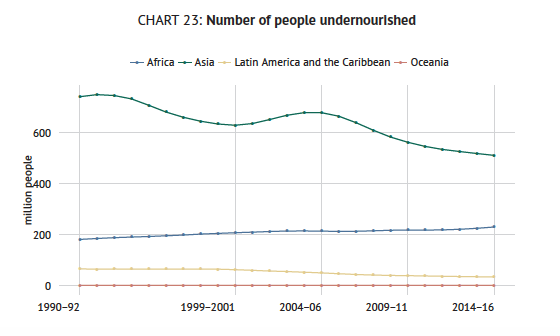The good news is that despite the fact that the world’s population has doubled in the last 50 years or so, Malthusian predictions about a shortage of food have been proven unfounded to date and only 10.8 % of humanity is considered undernourished as opposed to 18.6% 15 years ago. The bad news is there are still 793 million people in the world without enough to eat and climate change may have a devastating impact on the agricultural sector of more is not done to mitigate its effects and adapt the world’s food supply.

Complex System Dynamics
What makes this a complex topic to look at is that the system dynamics involved. Higher concentrations of atmospheric carbon, for example, will be good for plants in general. On the other hand, rising temperatures will, most likely, create a number of problems for agriculture which will potentially erase that benefit and make it more difficult to feed the planet. Negative impacts include:
- shorter growing seasons in many parts of the world
- higher co2 concentrations in soil
- increases in weeds, pests, and the growth of disease
- changing rainfall patters and an increase in both draughts and floods
- spreading desertification
- rising sea levels reducing land availability and increasing salinization
Water Stress
Agriculture currently consumes about 70% of the world’s fresh water and a significant part of the planet is currently undergoing significant water stress. There is a clear link between climate change. The great California draught over the last four years of draught costs it’s farmers over $ 1 billion per year! Although the last rainy season in California was considered to be back to normal, much of the state is still facing serious water shortages.
There is also a direct link between the severe draught which affected Syria between 2006 and 2010 and the civil war and refugee crisis.
Winners & Losers
According California’s Department of Agriculture, a warmer climate will be good for vegetables such as beans, onions, and sweet corn but will have a negative impact on other, thirstier crops which currently play an important role in the State’s economy such as fruits and nuts.
Worldwide, some countries will have seriously negative impacts, while others, in the far north and south, may see an improvement in agricultural conditions. In a post back in 2015 I made the point that champagne companies were buying up land in the United Kingdom due to the changing climate.
Stranded Assets
As part of the Sustainable Finance Program at Oxford University’s Smith School of Enterprise and the Environment, a study was published in 2013 which looked at the impact of climate change on agricultural land around the world. The study looked at risk factors and evaluated them in terms of the degree to which they were moving slow and fast and also whether the risk to land values would happen in the short or long term. Overall, the study found that these risks could decrease the value of the agricultural sector by trillions of dollars!
Time to Act
While the world has collectively recognized the importance of trying to slow climate change, the present U.S. Government is going the wrong way on almost every issue. Fortunately, a number of American cities and States such as California are still pursuing climate friendly policies and with a little bit of luck, the U.S. will go back to having a sensible and qualified president in 2020.
In any case, if someone was thinking about the future, they might consider buying a farm in Alaska.



Climate change has the potential to affect humans and all plants and animals in the world